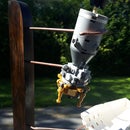Introduction: Handheld 2D Gopro Gimbal From Defective Drone Parts
Like most drone enthusiasts, I enjoy experimentation. Unfortunately, sometimes that experimentation can get a bit costly, but as a friend once said to me, "If you ain't breaking, you ain't making". So, when I decided that I would design and build my own 3D gimbal, for my Phantom 2, I immediately sourced out the required parts and set to construction, locating a control board, carbon fiber frame and brushless motors from Amazon.
Somehow, during fabrication, I ended up burning out the yaw on the control board and so I had to alter the setup for 2D operation. This meant that the gimbal was still able to handle roll (side to side movement), as well as pitch (front to back), but could no longer turn as the drone did. With that I altered the frame and finished installing the gimbal on my drone.
When I brought my Phantom out for it's maiden voyage, with its new gimbal, it (the gimbal) developed a very distinct vibration, only during hover, that no amount of tuning was able to rectify. It was then I realized that the vibration was due to the balance and weight being severely altered by the removal of the section responsible for yaw, making the gimbal completely useless for UAV use.
I then realized I could recycle the gimbal for a completely different application. Hand held gimbals can get very expensive, upwards of $500, and yet they are functionally no different than those available for drones. Since the total cost of my parts was less than $75, it occurred to me that I could rectify my initial failure, while creating a new tool that would be useful for future filming projects.
For this project, I decided to take one of the most despised item in pop culture and recycle it to a far better use...the selfie stick. Its ability to alter its angle, but more importantly, to extend its length, can add a huge amount of functionality to the gimbal. The trickiest part was supplying the 7-12V required to run the unit without adding excessive weight or bulk, making it unwieldy, while still offering long life, as well as, the ability to recharge the batteries as necessary.
Step 1: Tools and Supplies
Tools;
- Micro Drivers
- Allen Keys
- Soldering Iron
- Wire Cutters/Strippers
- Drill with 1/4" bit
- PC or Mac
- Hot Glue Gun
Supplies;
- 2D or 3D Gimbal
- Project Box
- Hobby Power Leads
- 18350 battery Sleds or equivalent connectors (I created mine out of old erector set pieces)
- Selfie Stick
- Tie Wraps
- Electrical Tape
- Foam Rubber (Not essential but good for Handle Wrap)
- Heat Shrink Tube
- 1/4"-20 hex bolt and nut 1.5 inches long
- Single Throw Power Switch
- 3 18350 700MAH Lithium Batteries
Step 2: Assemble Your Gimbal
Most gimbals rarely come fully assembled, especially if you source your parts separately. As mentioned, mine was created using a carbon fiber frame, motors and board that I sourced separately from Amazon, which had suffered some alteration. For this project you won't be needing the mounting plates or vibration dampers which may require remounting your control board in another location. I relocated mine on the back of the gimbal arm, ensuring that the sensor had enough length to reach the camera mount. With the removal of the yaw, I had to find a new place to mount the sensor, which I did by hot gluing a strip of plastic to the side of the camera frame.
**Note** It's very important that you get the orientation of your sensor correct as it is responsible for passing information about your camera to the controller. Refer to the manual, for your controller or gimbal for correct positioning.
Step 3: Creating Your Battery Pack
The battery pack is comprised of three 3.8V batteries in a project box, with a single throw switch, and a hobby power connector. The batteries are connected in series for a final output of 11.4V-12V.
I wanted the battery pack to be relatively lightweight, and yet have long life so I opted to use three 18350 700MAH lithium batteries that can be easily acquired from any electronics store. The most effective way to install them would be by use of battery sleds, however, since my local shop was sold out, I ended up improvising by creating connectors out of old erector set parts. There are a lot of different ways you can make the connection if you can't find battery sleds specifically designed for 18350 batteries and don't want to wait for some to be shipped via ordering them online. I've taken AA battery sleds and modified them and even used pieces of spring soldered together with wire without problem. Just ensure your connections are solid, and your batteries are held firmly in whatever setup you opt to use. I like to line the inside of the box with adhesive foam as it prevents the batteries from moving due to jolts or bumps.
The full weight of the battery pack ended up being under 2 ounces and provided 4 hours of continuous use making it perfect for the application. Total cost of the batteries and project box ended up being under $15.
**Note on erector sets** These are fantastic for a variety of projects as they allow you to assemble strong, bolt together, frames and brackets that can be used for any project or application, such as this battery pack. I highly recommend keeping a few kits in your shop, and if you can't find them at your local toy store, they usually end up in bulk bags at the local Goodwill.
Step 4: Programming Your Gimbal
Programming is very specific to the board controlling your gimbal, and can be tricky for the first time user. There are, however, some tricks and pointers I can offer to make the process easier for you.
**Note, the software I show isn't specific to the board I was using and is actually an older version designed for 2D use. I managed to re-flash the board (with a LOT of difficulty) with the older version, hoping it would add to the stability. It didn't, but it was worth a try.
First, I recommend installing your Gopro as your gimbal will require its weight to function properly. It would be a good idea to engage the wifi connection so that you can view video output as you're modifying the gimbal's settings. So that I could set my gimbal assembly down, and still view its operation, I created a small frame that consisted of two 5" pillars with a cross member, that it would be suspended from, allowing hands free operation. Next I attached the battery pack and made the electrical connection.
Programming;
I've used a few different gimbals and they all tend to employ the same essential functions, though they address them differently. In essence, however, it can be broken down into two distinct properties; motion and motor power.
Motor Power
When adjusting the motor power, it can be tempting to turn it up as it will improve stability, however a setting that is too high can damage the motor or control board through overheating. Yes, this is how I damaged this gimbal trying to install a camera that was too heavy for the motors. When programming power, I recommend setting the power at 1, then slowly increasing until the motors are just able to lift and move the camera housing properly. I then adjust 2-5 additional points to ensure smooth operation.
Movement
Different control boards use different metrics to adjust the movement of the gimbal, but they function the same way using what's called PID. (As you can see the software I'm using alters that to a set of gains that include velocity and acceleration). It's a great idea to educate yourself on how PID works, however, you don't really need to understand it to set it up. When programming your gimbal, you as the user are looking for 'vibrations' that can be caused when these numbers are set to high and sluggishness when they are too low. This is why you'll need to be able to manipulate your gimbal as you're setting it up.
In its simplest terms, the easiest way to adjust your settings is to turn them down to 1, just as you did with the motors, then slowly raise them until you start to see and feel a noticeable vibration in your camera, then reduce them until the vibration dissipates. It's not a flawless technique, by any means, but, should provide you with a good smooth platform for your filming until you learn to 'fine tune' it better.
Step 5: Mounting Your Selfie Stick Handle and Battery
Most selfie sticks are created the same and use a plastic hinge with a 1/4" x 20 threaded bolt to hold the phone bracket into place. Interestingly, it is the same thread used on most digital cameras as a tripod mount . Unfortunately for our purposes, this bolt is too short and so it needs to be replaced with a 1.5" hex bolt with the same thread. On the model I had, it was as simple as removing two screws, in the hinge, and removing the thumb turn bolt, then replacing it with the new hex bolt.
I created a bracket that would attach to the gimbal frame by, again, using my erector set, and drilling out a hole, in its center the diameter of the bolt. Installing the hinge piece was easy by passing the bolt through the frame, installing the bracket on the other side, then bolting it into place with a 1/4" x 20 self locking hex bolt.
Once the mounting hardware was in place, I reattached the handle and tested the operation. The diameter of the handle ended up being a bit small and so I cut a piece of adhesive foam rubber and wrapped it around the handle thickening it and making it more comfortable to use.
The Battery
Because of the design of the gimbal frame, there is a 'ledge' on the top where it is designed to mount to the drone body via the mounting brackets. This is a perfect location to set your battery pack where it won't interfere with operation and will give ready access. I had initially used some two way tape to secure it, but the quality of the tape I had on hand was a bit lacking, and so I used a tie wrap to secure it into place.
Step 6: Notes on Balancing Your Camera
For optimum operation, your camera should be perfectly balanced in its bracket, so that when the motors are off, it doesn't tip over or flop to one side or the other. This will go a long way, especially when you're programming your board for operation. As you can see on mine, with the removal of the extra parts, the camera sits 3/4" away from the edge of the frame, so to compensate, I added some lightweight foam to fill the gap and help secure the camera.
Step 7: Finished
That's it. When you're involved in a hobby, especially one as expensive as UAV piloting, it's beneficial if you can turn your failures into successes, and adding to your arsenal of tools via the recycling of old hardware represents the biggest success of all.
As usual, I hope you enjoyed the instructable and thanks for following.

Participated in the
Epilog Contest VII

Participated in the
Spectacular Failures Contest













